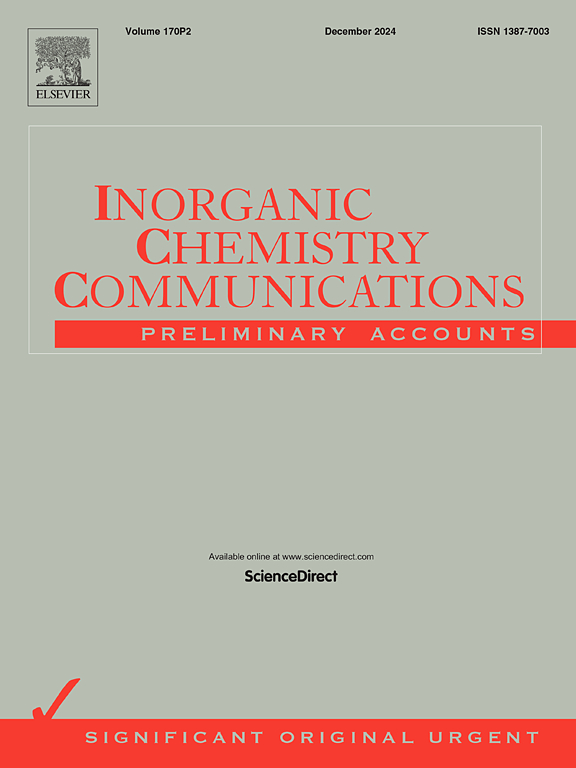具有增强过氧化物酶样活性和对映选择性的双金属纳米颗粒,用于D, l -色氨酸的比色鉴别
IF 4.4
3区 化学
Q1 CHEMISTRY, INORGANIC & NUCLEAR
引用次数: 0
摘要
单金属纳米酶的手性识别受到了广泛的关注。然而,确定双金属纳米酶的手性鉴定的基础是至关重要的,并提出了挑战。本文以l -色氨酸(LW)、l -组氨酸(LH)、l -脯氨酸、l -酪氨酸和l -二肽(LWLH)为手性配体,在铜纳米粒子表面修饰金纳米粒子(AuNPs),制备了4种双金属纳米酶(LWLH@CuNPs)。在这些纳米酶- h2o2体系中,底物3,3 ',5,5 ' -四甲基联苯胺(TMB)被有效氧化生成蓝色oxTMB,验证了它们的过氧化物酶样活性是由双金属纳米酶的协同作用产生的。值得注意的是,与其他三种双金属纳米酶和单金属纳米酶LWLH@CuNPs相比,当D, l -色氨酸(D, l -色氨酸)存在时,oxTMB在LW@AuNPs-LWLH@CuNPs-TMB-H2O2体系中650 nm处的可见吸光度明显改变。支持LW@AuNPs-LWLH@CuNPs增强手性辨别能力的机制是基于氢键和电子转移。此外,提出的LW@AuNPs-LWLH@CuNPs纳米酶被用于测量唾液样品中的l -色氨酸。这项研究加深了人们对将AuNPs结合到CuNPs上的优势的理解,特别是提高了双金属纳米酶的过氧化物酶样活性,并突出了它们对D, l -氨基酸的比色手性识别的潜力。本文章由计算机程序翻译,如有差异,请以英文原文为准。

Bimetallic nanoparticles with enhanced peroxidase-like activity and enantioselectivity for colorimetric discrimination of D,L-tryptophan
Chiral recognition by monometallic nanozymes has received extensive attention. However, determining the basis of the chiral identification properties of bimetallic nanozymes is critical and poses challenges. Herein, by leveraging L-tryptophan (LW), L-histidine (LH), L-proline, L-tyrosine and L-dipeptide (LWLH) as chiral ligands, four kinds of bimetallic nanozymes were fabricated based on gold nanoparticles (AuNPs) modified onto the surface of copper nanoparticles (LWLH@CuNPs) . The substrate 3,3′,5,5′-tetramethylbenzidine (TMB) was efficiently oxidized to yield blue oxTMB in these nanozymes-H2O2 systems, verifying their peroxidase-like activity that resulted from the synergistic effect of the bimetallic nanozymes. Notably, in the presence of D,L-tryptophan (D,L-Trp), the visible absorbance of oxTMB at 650 nm in the LW@AuNPs-LWLH@CuNPs-TMB-H2O2 system was significantly altered, in the contrast with the other three bimetallic nanozymes and monometallic LWLH@CuNPs. The mechanism underpinning the enhanced chiral discrimination ability of LW@AuNPs-LWLH@CuNPs was based on hydrogen-bonding and electron transfer. Furthermore, the proposed LW@AuNPs-LWLH@CuNPs nanozymes were applied to measure L-Trp in saliva samples. This study deepens understanding of the advantages of incorporating AuNPs onto CuNPs, specifically, improving the peroxidase-like activity of bimetallic nanozymes and highlighting their potential for colorimetric chiral recognition of D,L-amino acids.
求助全文
通过发布文献求助,成功后即可免费获取论文全文。
去求助
来源期刊

Inorganic Chemistry Communications
化学-无机化学与核化学
CiteScore
5.50
自引率
7.90%
发文量
1013
审稿时长
53 days
期刊介绍:
Launched in January 1998, Inorganic Chemistry Communications is an international journal dedicated to the rapid publication of short communications in the major areas of inorganic, organometallic and supramolecular chemistry. Topics include synthetic and reaction chemistry, kinetics and mechanisms of reactions, bioinorganic chemistry, photochemistry and the use of metal and organometallic compounds in stoichiometric and catalytic synthesis or organic compounds.
 求助内容:
求助内容: 应助结果提醒方式:
应助结果提醒方式:


